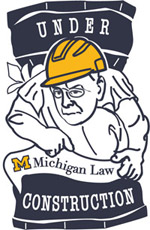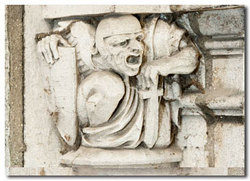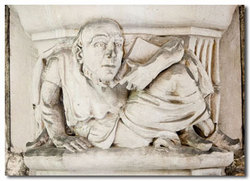University of Michigan Law Quad's corbels tell a story
The Law Quad is probably the University of Michigan's single greatest architectural achievement. It is one of the most attractive places on campus and a big selling point when prospective law students come to Ann Arbor.
The Law Quad was built for the university by Michigan Law alum William W. Cook (Class of 1880 undergrad, class of 1882 law school) after the successful New York attorney wrote the Board of Regents in 1922 asking if he could contribute funds for "a law students' combined club and dormitory building.”
Cook died in 1930, three years before the project was completed. The Cook Law Quadrangle, as it is officially known, is made up of Hutchins Hall, the John P. Cook dormitory, the Lawyers Club dormitory, and the Legal Research Building.
Two major additions are being made to the law school right now: A new academic building, across from the Law Quad on Monroe Street, and a two-level student center, the Robert B. Aiken Commons, which is designed as the new "heart" of the law school. Both facilities are scheduled to open in January 2012.

Former U-M President Harry Burns Hutchins' corbel is being used as the face of the law school's construction project.
Courtesy, University of Michigan Law School.
Among the more curious of the Law Quad's features are its corbels - better known as gargoyles, or atlas figures - manning the three entrances to the quad along South University Avenue.
In 1993, Ilene Forsyth's "The Uses of Art: Medieval architecture in the Michigan Law Quadrangle" explained the origins of the corbels. Fortunately for non-architecture lovers who are nonetheless curious, a page on the law school's Web site, based on Forsyth's research, reveals what the Law Quad's architects had in mind when designing each of the 22 corbels.

Courtesy, University of Michigan Law School.
Corbels off the central passage were designed in homage to several University of Michigan presidents credited with making the university great, such as James Burrill Angell, Marion Leroy Burton and Erastus O. Haven. President Harry Burns Hutchins, meanwhile, is represented in corbel form and his name lives on through the law school's main academic building, Hutchins Hall. Hutchins's corbel is also the face of the law school's construction project.
No women, no regents and no professors are represented on the corbels.
The west passage, nearest to the corner of South University and South State Street, offers a spare collection of four corbels, all themed to represent academic pursuits at the university, from astronomy to business to medicine to military science.
It's been decades since the university has taken an active role in preparing its students for military service. Outside of the ROTC program - which is all but mandatory for universities using federal funds - the opportunities for military training are more or less non-existent at the university.

U-M President James B. Angell. Note the difference between this corbel, meant to represent an actual person, and the other, meant to represent an academic discipline.
Courtesy, University of Michigan Law School.
That wasn't always the case, particularly when the Law Quad was built, between "the war to end all wars" and the only war in history that was more destructive - World War II.
During World War II, campus life was turned topsy-turvy as all physically-able men were required to take 4.5 hours a week of "physical hardening" courses, and cannon blasts marked the start and end of each day.
The Law Quad's east passage, off the corner of Tappan and South University, features corbels embodying some of the great pastimes of the university, from learning (the architect, the engineer, and of course the jurist) to athletics (the football player in fall, the hockey player in winter).
Other corbels in the east passage honor each of the four seasons.
Next time you're taking a walk in the Law Quad, take a closer look at the corbels. They tell a pretty interesting story about how the University of Michigan saw itself in the early 20th century.
James David Dickson can be reached at JamesDickson@AnnArbor.com


Comments
Ethics Advocate
Mon, Feb 1, 2010 : 7:52 p.m.
I love the Law School quad architecture, too--because I went to Yale and the quad is exactly the same style as several of their dormitories (which they call colleges). Also, like Yale, their above-ground library has some lovely cathedral appearance both outside and inside. It's too bad that style is prohibitively expensive to duplicate any more.
Ponycar
Mon, Feb 1, 2010 : 10:21 a.m.
What's wrong with gothic atavisms? They're pretty cool! The buildings themselvs are the best looking on campus. What was so special about the old B school building? And of course Hill Auditorium and the Burton Carillon are nothing special. Ditto the Engineering Arch and surrounding buildings. Granted, I would LOVE to see the ugly grey (1950's?) top floor additions to the one law school building removed. What the hell were they thinking?
Tom Wilkinson
Mon, Feb 1, 2010 : 6:44 a.m.
The first sentence of this article is both right and wrong. Possibly the Law Quad is the University's greatest architectural achievement. Since the University has very few such achievements, this pastiche of gothic atavisms is no worse than most of the other buildings. With the destruction of the old business school and the construction of the monstrosity that replaced it, the University has essentially completed its program of architectural genocide.
Eric S
Sun, Jan 31, 2010 : 2:37 p.m.
Nice story. However, the links to this story go to the wrong directory (/news/ vs. /weird/), so not many people are seeing it.